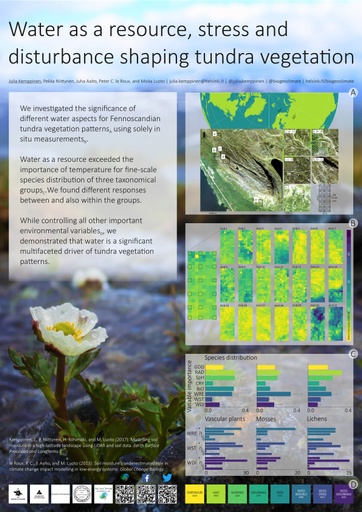pdf Water as a resource, stress and disturbance shaping tundra vegetation Popular
1814 downloads

Julia Kemppinen
University of Helsinki
Niittynen, Pekka, University of Helsinki, Helsinki, FinlandAalto
Juha, University of Helsinki, Helsinki, Finlandle Roux, Peter C., University of Pretoria
Pretoria, South AfricaLuoto, Miska, University of Helsinki, Helsinki, Finland
 The Arctic biodiversity is on the verge of a great change. The hydrological cycleof the Arctic has intensified and the impacts are experienced by vegetation.Vegetation is limited by water resources, but water forms also major stress anddisturbance. However, climate change impact studies on fine-scale vegetationpatterns often cover water inadequately in the Arctic, which is considered as anenergy-limited ecosystem. This key gap in knowledge must be addressed forbetter understanding of the impacts of changing hydrology on the Arcticbiodiversity. Thus, we investigated if the inclusion of different water factorsimproved species distribution models of vascular plants, mosses, and lichens –the cornerstone taxa of the Arctic biodiversity.Our results highlight the role of water as a multifaceted driver of fine-scaletundra vegetation patterns. While controlling all other key environmentalgradients (e.g. temperature), the three water aspects proved to be crucial. Eachwater aspect had different impacts on the distribution of individual species.Acknowledging the uncertainties in the anticipated rapid and significant changesin tundra hydrology, there are possibly ecological surprises ahead of us. Thus,we stress the inclusion of ecologically meaningful water aspects for improvingour knowledge on the fine-scale vegetation patterns in the Arctic.
The Arctic biodiversity is on the verge of a great change. The hydrological cycleof the Arctic has intensified and the impacts are experienced by vegetation.Vegetation is limited by water resources, but water forms also major stress anddisturbance. However, climate change impact studies on fine-scale vegetationpatterns often cover water inadequately in the Arctic, which is considered as anenergy-limited ecosystem. This key gap in knowledge must be addressed forbetter understanding of the impacts of changing hydrology on the Arcticbiodiversity. Thus, we investigated if the inclusion of different water factorsimproved species distribution models of vascular plants, mosses, and lichens –the cornerstone taxa of the Arctic biodiversity.Our results highlight the role of water as a multifaceted driver of fine-scaletundra vegetation patterns. While controlling all other key environmentalgradients (e.g. temperature), the three water aspects proved to be crucial. Eachwater aspect had different impacts on the distribution of individual species.Acknowledging the uncertainties in the anticipated rapid and significant changesin tundra hydrology, there are possibly ecological surprises ahead of us. Thus,we stress the inclusion of ecologically meaningful water aspects for improvingour knowledge on the fine-scale vegetation patterns in the Arctic.

